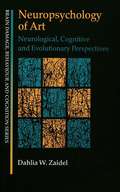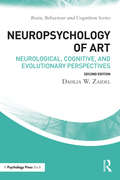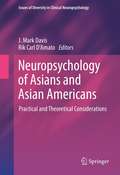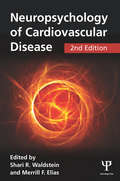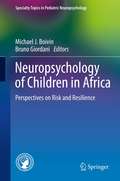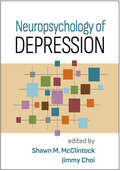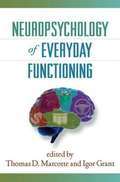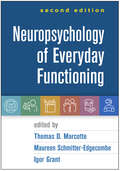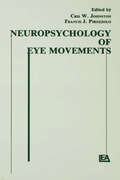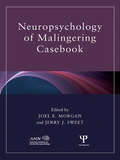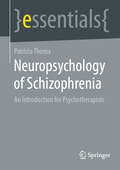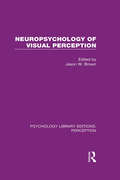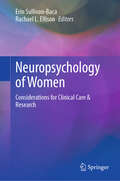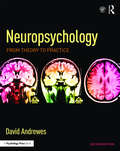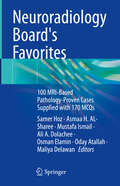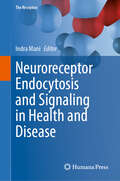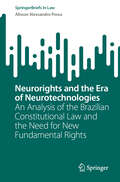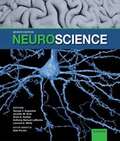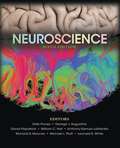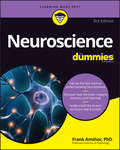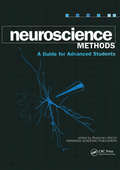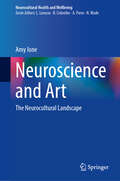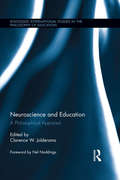- Table View
- List View
Neuropsychology of Art: Neurological, Cognitive and Evolutionary Perspectives (Brain, Behaviour and Cognition)
by Dahlia W. ZaidelThe significance of art in human existence has long been a source of puzzlement, fascination, and mystery. In Neuropsychology of Art, Dahlia W. Zaidel explores the brain regions and neuronal systems that support artistic creativity, talent, and appreciation.Both the visual and musical arts are discussed against a neurological background. Evidence from the latest relevant brain research is presented and critically examined in an attempt to clarify the brain-art relationship, language processing and visuo-spatial perception. The consequences of perceptual problems in famous artists, along with data from autistic savants and established artists with brain damage as a result of unilateral stroke, dementia, or other neurological conditions, are brought into consideration and the effects of damage to specific regions of the brain explored. A major compilation of rare cases of artists with brain damage is provided and the cognitive abilities required for the neuropsychology of art reviewed.This book draws on interdisciplinary principles from the biology of art, brain evolution, anthropology, and the cinema through to the question of beauty, language, perception, and hemispheric specialization. It will be of interest to advanced students in neuro-psychology, neuroscience and neurology, to clinicians and all researchers and scholars interested in the workings of the human brain.
Neuropsychology of Art: Neurological, Cognitive, and Evolutionary Perspectives (Brain, Behaviour and Cognition)
by Dahlia W. ZaidelFully updated, the second edition of Neuropsychology of Art offers a fascinating exploration of the brain regions and neuronal systems which support artistic creativity, talent and appreciation. This landmark book is the first to draw upon neurological, evolutionary, and cognitive perspectives, and to provide an extensive compilation of neurological case studies of professional painters, composers and musicians. The book presents evidence from the latest brain research, and develops a multidisciplinary approach, drawing upon theories of brain evolution, biology of art, art trends, archaeology, and anthropology. It considers the consequences of brain damage to the creation of art and the brain’s control of art. The author delves into a variety of neurological conditions in established artists, including unilateral stroke, dementia, Alzheimer’s Disease, Parkinson’s Disease, and also evidence from savants with autism. Written by a leading neuropsychologist, Neuropsychology of Art will be of great interest to students and researchers in neuropsychology, cognitive psychology, neuroscience, and neurology, and also to clinicians in art therapy.
Neuropsychology of Asians and Asian-Americans: Practical and Theoretical Considerations
by J. Mark Davis Rik Carl D'AmatoNeuropschology with Asians and Asian Americans Practical and Theoretical Considerations J. Mark Davis and Rik Carl D'Amato, editors The challenge of cultural competence for health providers is more than the recognition of other ethnicities: it entails the balancing of group and individual factors to apply relevant information in diagnostic and therapeutic settings. Particularly in need of culturally appropriate services are Asians and Asian Americans, populations that are diverse, growing, and underserved by Asian practitioners. Neuropsychology with Asians and Asian Americans takes cultural neuroscience to new levels in its variety and usefulness. Focusing on the largest groups of Far East and Southeast Asian descent, this leading-edge reference examines the influence of culture on psychological processes and identifies sociocultural factors as they influence neurological aspects of client presentation. This expert coverage goes beyond well-known constructs of "collectivism" and "family orientation" toward establishing an evidence base crucial to understanding, assessing, and treating Asian and Asian American clients, including: Linguistic factors and language assessment of Asians.Society and acculturation in Asian and Asian American communitiesMental illness from Asian and Asian American perspectives.Understanding cognitive differences across the lifespan: comparing Eastern and Western culturesClinical interviews and qualitative assessment with Asian clientsNeuropsychological test selection with Asian clients Unique in its scope and detail, Neuropsychology with Asians and Asian Americans is a necessary resource for neuropsychologists and rehabilitation specialists as well as social workers and clinical, counseling, and school psychologists.
Neuropsychology of Cardiovascular Disease
by Shari R. Waldstein Merrill F. EliasCardiovascular disease (CVD) is the leading cause of morbidity and mortality in the United States and most westernized nations. Both CVDs and their risk factors confer substantial risk for stroke and dementia, but are also associated with more subtle changes in brain structure and function and cognitive performance prior to such devastating clinical outcomes. It has been suggested that there exists a continuum of brain abnormalities and cognitive difficulties associated with increasingly severe manifestations of cardiovascular risk factors and diseases that precede vascular cognitive impairment and may ultimately culminate in stroke or dementia. This second edition examines the relations of a host of behavioral and biomedical risk factors, in addition to subclinical and clinical CVDs, to brain and cognitive function. Associations with dementia and pre-dementia cognitive performance are reported, described, and discussed with a focus on underlying brain mechanisms. Future research agendas are suggested, and clinical implications are considered. The volume is a resource for professionals and students in neuropsychology, behavioral medicine, neurology, cardiology, cardiovascular and behavioral epidemiology, gerontology, geriatric medicine, nursing, adult developmental psychology, and for other physicians and health care professionals who work with patients with, or at risk for, CVDs.
Neuropsychology of Children in Africa
by Bruno Giordani Michael J. BoivinIncreasingly, global humanitarian efforts are focusing on improving the lives of children. And among the developing world, the African nations are particularly affected by extreme weather conditions, devastating pandemics, and armed conflict. Neurocognitive science offers significant avenues toward bringing needed aid to the continent while creating a template for helping children worldwide. The studies in Neuropsychology of Children in Africa clearly illustrate how the brain develops and adjusts in the face of adversity. Contributors span assessment approaches and public health risk factors, and represent established topics and emerging lines of research, including biocultural constructs and genomic technologies. Together, these chapters argue for methodology that is culturally sensitive, scientifically rigorous, consistent, and sustainable. And although the focus is pediatric, the book takes a lifespan approach to prevention and intervention, modeling a universal framework for understanding neurocognitive development. Included in the coverage: Assessment of very young children in Africa in the context of HIV.Psychosocial aspects of malnutrition among African children.Assessment of neuropsychological outcomes in pediatric severe malaria.Neurodisability screening using the Ten Questions questionnaire.The neuropsychology of sickle cell disease in West African children.Computerized Cognitive Rehabilitation Therapy for African children. As a guide to current findings or a springboard for new studies, Neuropsychology of Children in Africa is a necessary reference for researchers, policymakers, and diverse professionals in global aid organizations, and across the discipline.
Neuropsychology of Depression
by Shawn M. McClintock and Jimmy ChoiTimely and authoritative, this unique volume focuses on neurocognitive aspects of depression and their implications for assessment, evaluation, clinical management, and research. Experts in the field explore the impact of depression on executive function, learning and memory, working memory, and other critical capacities, and present cutting-edge assessment tools and procedures. The neurocognitive effects of widely used antidepressant treatments are reviewed, from psychotropic medications and evidence-based psychotherapies to established and emerging neuromodulation technologies. Practical aspects of working with adults across the lifespan with depression are addressed, including ways to strengthen treatment engagement and adherence, and to incorporate cultural considerations.
Neuropsychology of Everyday Functioning
by Igor Grant Thomas MarcotteWhile neuropsychological testing can accurately detect cognitive deficits in persons with brain injury, the ability to reliably predict how these individuals will function in everyday life has remained elusive. This authoritative volume brings together well-known experts to present recent advances in the neuropsychological assessment of key real-world capacities the ability to live independently, work, manage medications, and drive a car. For each of these domains, contributors describe cutting-edge tests, procedures, and interpretive strategies and examine salient theoretical and methodological issues. Chapters also review approaches for evaluating specific populations, including older adults and patients with traumatic brain injury, depression, dementia, schizophrenia, and other neurological and psychiatric disorders.
Neuropsychology of Everyday Functioning, Second Edition
by Igor Grant Thomas D. Marcotte Maureen Schmitter-EdgecombeThe go-to resource for assessing and predicting functional abilities in persons with brain injury or cognitive decline has now been revised and expanded to reflect significant advances in the field. With a focus on key real-world capacities--independent living, vocational functioning, medication management, and driving--leading experts explore how individuals go about their daily lives, where and why disruptions occur, and potential opportunities for improving function. Strategies for direct assessment are reviewed, from standard neuropsychological tests to multimodal approaches and technology-based tools. Chapters also provide functional assessment guidance for specific neurological and psychiatric conditions: dementia, traumatic brain injury, depression, schizophrenia, and others. New to This Edition *Incorporates over a decade of technological and methodological innovations. *Chapter on theories and models of everyday functioning. *Chapters on naturalistic assessment, wearable sensors, ambulatory assessment, and virtual-reality-based tools. *Practical clinical implications are highlighted throughout.
Neuropsychology of Eye Movement (Neuropsychology and Neurolinguistics Series)
by Francis J. Pirozzolo Cris W. JohnstonFirst Published in 1988. The idea for this book arose from a desire to bring together relevant information from the fields of vision research, neuropsychology, neurology, and psychiatry. The selection of topics covered by N europsychology of Eye Movements conforms to the primary areas of inquiry that currently exist. Unlike the majority of other books on eye movements, which represent proceedings of meetings, this volume is com prised of a number of critical review s of the research literature.
Neuropsychology of Malingering Casebook (American Academy of Clinical Neuropsychology/Routledge Continuing Education Series)
by Joel E. Morgan Jerry J. SweetClinical neuropsychologists frequently evaluate individuals within a forensic context, and therefore must address questions regarding the possible presence of reduced effort, response bias and/or malingering. This volume offers a wide range of instructive real-world case examples involving the complex differential diagnosis where symptom exaggeration and/or malingering cloud the picture. Written by expert forensic neuropsychologists, the scenarios described provide informed, empirically-based and scientifically-derived opinions on the topic. Issues related to malingering, such as response bias and insufficient effort, are discussed thoroughly with regard to a large number of clinical conditions and assessment instruments. Test data and non-test information are considered and integrated by the numerous experts. Expert guidance for clinicians who must address the issue of malingering is provided in a straightforward and well-organized format. To date, there has not been a comparable collection of rich case material relevant to forensic practice in clinical neuropsychology.
Neuropsychology of Schizophrenia: An Introduction for Psychotherapists (essentials)
by Patrizia ThomaThis essential discusses schizophrenia in a brief, concise manner in light of its developmental neurobiological pathology. It primarily addresses current neuropsychological findings on cognitive dysfunction in schizophrenia as well as common neuropsychological models to explain the complex and heterogeneous psychopathology. A primary concern of the book is to clarify the extent to which these findings can play a role in the treatment of schizophrenia with regard to their use in psychoeducation as well as the design of (meta)cognitive therapy programs. This Springer essential is a translation of the original German 1st edition essentials, Neuropsychologie der Schizophrenie by Patrizia Thoma, published by Springer Fachmedien Wiesbaden GmbH, part of Springer Nature in 2019. The translation was done with the help of artificial intelligence (machine translation by the service DeepL.com). A subsequent human revision was done primarily in terms of content, so that the book will read stylistically different from a conventional translation. Springer Nature works continuously to further the development of tools for the production of books and on the related technologies to support the authors.
Neuropsychology of Visual Perception (Psychology Library Editions: Perception #2)
by Jason W. BrownOriginally published in 1989, this sourcebook for anatomic studies in the neuropsychology of visual perception contains chapters on disorders of visual agnosias, impaired object perception and spatial neglect, and abnormal visual imagery. The neurological basis of visual perception and the disorders that result from brain damage are discussed. At the time the chapters in this volume constituted a state of the art survey in this area and provided data that were essential for the development of models of normal image and object formation.
Neuropsychology of Women: Considerations for Clinical Care & Research
by Erin Sullivan-Baca Rachael L. EllisonWomen have long been underrepresented in scientific research, which has limited our understanding of how they may be uniquely impacted by various medical, psychological, and neurocognitive conditions. Due to this limitation, neuropsychological training and practice has historically fallen short of acknowledging potential sex and gender differences and effectively incorporating this knowledge into evaluations and treatment recommendations. Fortunately, in recent years, contemporary research has begun to draw more focus on unique biopsychosocial factors impacting the epidemiology, presentation, neurocognitive profile, and treatment implications for women with neuropsychological concerns. In an age of increased focus on diversity, equity, and inclusion (DEI) in the field of neuropsychology, compounded by the background of everchanging socio-political factors in the U.S. either supporting or opposing this focus, it is crucial that clinical neuropsychologists gain the knowledge and skills to provide individualized, gender-informed care to women patients. It is imperative for neuropsychology as a specialty to champion this initiative as leading experts in the intersection of cognition, mental health and disorders pertaining to the brain, which has the potential to inform clinical practice and research in related fields such as medicine and neuroscience. Neuropsychology of Women: Considerations for Clinical Care & Research provides an overview of the current research-informed knowledge base on how different conditions encountered in neuropsychological practice uniquely present in women patients. Chapters are authored by some of the foremost neuropsychological researchers and clinicians of today, spanning topics inclusive of both those impacting both genders, with a focus on the understudied and unique clinical implications related to women, as well as those disproportionately affecting women. These range from specific neurodegenerative conditions such as Alzheimer&’s disease and movement disorders, to acute events like stroke and traumatic brain injury, to chronic conditions including autoimmune disorders and epilepsy, all consolidating the literature into a concise and accessible format. Chapters focusing on chronic health conditions and issues relating to pregnancy and menopause supplement those focused on neurological conditions to help clinical providers conceptualize patients through a comprehensive neuropsychological lens and to help researchers understand where opportunities lie for further exploration. For those new to the field of neuropsychology, including students and trainees, Neuropsychology of Women: Considerations for Clinical Care & Research extends beyond traditional texts to incorporate issues of DEI through an intentional and organic approach. This is the first book of its kind in over a decade and the most comprehensive resource available to clinical neuropsychologists seeking to provide the highest standard of inclusive practice to women patients.
Neuropsychology: From Theory to Practice
by David AndrewesThe second edition of this comprehensive textbook for students of Neuropsychology gives a thorough overview of the complex relationship between brain and behaviour. With an excellent blend of clinical, experimental and theoretical coverage, it draws on the latest research findings from neuroscience, cognitive neuroscience, neurochemistry, clinical neuropsychology and neuropsychology to provide students with new insights in this fast moving field. The book is organised around the main neuropsychological disorders in the areas of perception, executive dysfunction, attention, memory, cerebral asymmetry, language, emotion and consciousness. There is a clear emphasis on bridging the gap between theory and practice with links throughout to clinical issues of both assessment and rehabilitation to build a clear understanding of the application of the theoretical issues. The final section in each chapter illustrates the importance of a more systematic approach to intervention, which takes into account theoretical views of recovery from brain damage. New to this edition: A new chapter format that includes a "basic topic" section, which contains up-to-date essential knowledge of the topic and a "further topics" section for a more advanced treatment of the area. A new section on neuroscientific approaches to rehabilitation in each chapter to make links between scientific knowledge and clinical treatment. A brand new chapter on consciousness A new full colour layout with increased pedagogical features, including key terms, section summaries, 'study questions' and improved presentation of figures and brain diagrams A companion website including related weblinks, guidance on answering the 'study questions', and flashcards. This book will be invaluable for undergraduate students in Neuropsychology and students who wish to take the subject further to the various clinical fields.
Neuroradiology Board's Favorites: 100 MRI-Based Pathology-Proven Cases Supplied with 170 MCQs
by Ali A. Dolachee Mustafa Ismail Oday Atallah Maliya Delawan Samer Hoz Asmaa H. AL-Sharee Osman ElaminThe Neuroradiology Board’s Favorites is a case-based review book focused on the imaging of pathology-proven lesions related to the central nervous system.The mission of this book is to help readers revise the core concepts and maintain knowledge of neuroradiology from radiology, neurology, and neurosurgical perspectives. This study companion features a unique design and is structured in two sections, totalling 15 chapters. It includes 100 clinical scenarios and imaging, supplemented by more than 170 multiple-choice questions in a convenient format suitable for self-study. The questions are attached to each case scenario in a style that mirrors the format adopted by the majority of local, regional, and international board examinations. The answers and explanations appear immediately below the questions to enhance readability. The content of this book is an adjunct to existing texts and does not intend to be the primary source of information; it aims to help readers identify their relevant strengths and weaknesses in the area and is based on the most up-to-date best practice evidence. This book is targeted at students of radiology, neurology, neurosurgery, and neurosciences. In addition, it can be beneficial for residents, fellows, and young attendings to prepare for exams or practice.
Neuroreceptor Endocytosis and Signaling in Health and Disease (The Receptors #2)
by Indra ManiThis book covers a wide range of neuroreceptor topics, including receptor endocytosis and signaling and the role of neuroreceptors in health and disease conditions. It focuses on various important nervous system receptors and their biomedical applications, especially receptor signaling. The book provides a look into the current developments of various neuroreceptors responsible for pathophysiological conditions. It is a valuable, cutting-edge, in-depth reference on neuroreceptors, featuring clearly written chapters from major contributors in the field. The central aim is to aid future investigators, researchers, students, and stakeholders to perform their research with greater ease. This book provides an excellent basis from which scientific knowledge can grow, widen, and accelerate receptor biology tools toward biomedical applications.
Neurorights and the Era of Neurotechnologies: An Analysis of the Brazilian Constitutional Law and the Need for New Fundamental Rights (SpringerBriefs in Law)
by Alisson Alexsandro PossaThis book provides an in-depth study on the theory of fundamental rights and the legal challenges posed by new technologies, with a particular focus on neurotechnologies and neurorights. The book begins with an overview of the evolution of neuroscience and neurotechnology, highlighting the current challenges these advancements pose to contemporary legal frameworks. It also discusses the potential for widespread adoption of these technologies, driven by significant investments from tech companies. The first chapter delves into the development of neuroscience and neurotechnology, emphasizing the legal implications and future concerns associated with their mass adoption. It explores how these technologies are being integrated into society and the legal challenges they present. The second chapter examines the concept of neurorights, identifying the legal objects these rights aim to protect and the new risks introduced by neurotechnologies. It provides a comprehensive review of the main neurorights proposals from recent decades, with a detailed analysis of the theoretical framework proposed by Marcello Ienca and Roberto Andorno in 2017. Their proposal includes four new human rights: cognitive freedom, mental privacy, mental integrity, and psychological continuity. The final chapter analyzes the relationship between neurorights and existing constitutional protections, focusing on the protection of human dignity. It discusses the right to free development of personality, physical and psychological integrity, and privacy and data protection. The chapter draws on theories of fundamental rights from Brazilian constitutionalists to provide a thorough examination of these issues. The book offers a broad analysis of the main neurorights proposals by international researchers, comparing them with the fundamental rights recognized in the Brazilian Constitution. It aims to determine whether new fundamental rights are necessary to protect Brazilian citizens from the potential harms of neurotechnology. This study is essential for researchers in neuroethics, neurorights, and fundamental rights, providing valuable insights into the intersection of law and emerging technologies.
Neurorobotics: Connecting the Brain, Body, and Environment (Intelligent Robotics and Autonomous Agents series)
by Jeffrey L. Krichmar Tiffany J. HwuAn introduction to neurorobotics that presents approaches and design principles for developing intelligent autonomous systems grounded in biology and neuroscience.Neurorobotics is an interdisciplinary field that draws on artificial intelligence, cognitive sciences, computer science, engineering, psychology, neuroscience, and robotics. Because the brain is closely coupled to the body and situated in the environment, neurorobots—autonomous systems modeled after some aspect of the brain—offer a powerful tool for studying neural function and may also be a means for developing autonomous systems with intelligence that rivals that of biological organisms. This textbook introduces approaches and design principles for developing intelligent autonomous systems grounded in biology and neuroscience. It is written for anyone interested in learning about this topic and can be used in cognitive robotics courses for students in psychology, cognitive science, and computer science.Neurorobotics covers the background and foundations of the field, with information on early neurorobots, relevant principles of neuroscience, learning rules and mechanisms, and reinforcement learning and prediction; neurorobot design principles grounded in neuroscience and principles of neuroscience research; and examples of neurorobots for navigation, developmental robotics, and social robots, presented with the cognitive science and neuroscience background that inspired them. A supplementary website offers videos, robot simulations, and links to software repositories with neurorobot examples.
Neuroscience
by Scott A. Huettel Jennifer M. Groh George J. Augustine Anthony-Samuel LaMantia Leonard E. White and Emeritus Editor Dale PurvesFor more than twenty-five years, Neuroscience has been the most comprehensive and clearly written neuroscience textbook on the market. This level of excellence continues in the seventh edition, with a balance of animal, human, and clinical studies that discuss the dynamic field of neuroscience from cellular signaling to cognitive function. New learning objectives and more concise sections make the content even more accessible than before. Neuroscience provides a bridge between the undergraduate and medical school worlds. It brings the relevance of neuroscience to both those exploring careers in the field as undergraduates and those developing core neuroscience understanding for medical school. It accomplishes this by presenting a balance of animal, human, and clinical studies that discuss the dynamic field of neuroscience from cellular signaling to cognitive function.
Neuroscience (Fifth Edition): Fundamentals For Rehabilitation
by Laurie Lundy-EkmanBoost your skills in planning and managing physical rehabilitation! Neuroscience: Fundamentals for Rehabilitation, 5th Edition provides a practical guide to the nervous system and how it affects the practice of physical and occupational therapy. Case studies and first-person stories from people with neurologic disorders make it easier to apply your knowledge to the clinical setting. New to this edition are new chapters on neuroanatomy imaging and neurologic examination techniques. Written by noted PT educator Laurie Lundy-Ekman, this book uses evidence-based research to help you understand neurologic disorders and treat clients who have physical limitations due to nervous system damage or disease.
Neuroscience (Sixth Edition)
by David Fitzpatrick Dale Purves Michael L. Platt George J. Augustine William C. Hall Anthony-Samuel LaMantia Richard D. Mooney Leonard E. WhiteThis practical guide connects the theory of neuroscience with real-world clinical application by utilizing first person accounts of neurological disorders and in-depth case studies. It also provides clear descriptions of a complete range of neurological disorders. <P><P>Special features such as "at-a-glance" summaries, pathology boxes, and hundreds of full-color illustrations, enhance the learning experience and make it easy to master the fundamentals of neuroscience rehabilitation.
Neuroscience For Dummies
by Frank AmthorA fascinating look at what’s rattling around in your skull Neuroscience For Dummies introduces you to the mind-boggling study of the human brain. It tracks to the content of a typical introductory neuroscience class at the college level —and it’s perfect for anyone curious about what makes us tick. New technologies and an explosion of research have completely transformed our understanding of memory, depression, the mind-body connection, learning, and genetics. This updated edition—still in classic, beginner-friendly Dummies style—covers the latest research advances and technologies in the field of neuroscience. Put some knowledge about the brain into your brain. Grasp the basic concepts and applications of neuroscience Understand the brain’s structure and function Explore how the brain impacts memory, learning, and emotions Discover how the brain is connected with other physical systemsFor students and general readers alike, Neuroscience For Dummies is a great way to understand what’s going on inside our heads.
Neuroscience Methods: A Guide for Advanced Students
by Rosemary MartinUnique in its coverage of such an extensive range of methods, Neuroscience Methods: A Guide for Advanced Students provides easy-to-understand descriptions of the many different techniques that are currently being used to study the brain at the molecular and cellular levels. This valuable reference text will help rescue undergraduate and postgraduate students from continuing bewilderment at the methods sections of current neuroscience publications.Topics covered include in vivo and in vitro preparations, electrophysiological, histochemical, hybridization and genetic techniques, measurement of cellular ion concentrations, methods of drug application, production of antibodies, expression systems, and neural grafting.
Neuroscience and Art: The Neurocultural Landscape (Neurocultural Health and Wellbeing)
by Amy IoneThis book is focused on how understanding ourselves as humans is incomplete without considering both biological and cultural aspects. Using the neurocultural perspective, the book explores how everything in the world is filtered back and forth through the brain and culture. The thrust of the book, therefore, is to explore the power of art in creating a bridge between cultural and neuroscientific lines of inquiry. Looking at both clinical and non-clinical populations, the text examines historical foundations, distinguishes congenital/developmental conditions from those that are acquired, and emphasizes how the brain constructs our sensory experiences. Several distinctive features separate this research from other publications. First, the book opens with a review of how the historical literature is still etched into the ideas we employ to explain elements across the interdisciplinary fields of art, aesthetics, our sensory experience, psychology, cognition, and well-being. Second, the research adopts a humanistic rather than a philosophical or social science perspective in demonstrating the value of coupling anatomy and physiology with the natural and social environment. In this, artists from all genres are incorporated. Among them are Iris Murdoch, Ludwig van Beethoven, Leonardo da Vinci, Cristoforo de Predis, Rembrandt, Federico Fellini, Chuck Close, and David Hockney. Case studies demonstrate how neuroscientific research meshes with art, individual, and cultural variables in ways that range from health and well-being to physiological decline and biological traumas. These include a case study that examines how Oliver Sacks combined biology and biography in his writings. It also explores art projects in several genres inspired by his studies. Another case study is on the role of film as a useful clinical tool. Here the book also demonstrates that cinematic devices used by filmmakers intersect with perceptual and cognitive neuroscience. A defining feature of the analysis is the integration of research on brain injuries with humanistic responses in film, literature, and the visual arts. This section outlines the lack of consensus regarding the causes and treatment of “shell shock” in World War I before introducing how research and art now work with PTSD/TBI. Finally, the book examines therapeutic cases of professional and non-professional artists, concluding with a discussion of synesthesia and the senses.
Neuroscience and Education: A Philosophical Appraisal (Routledge International Studies in the Philosophy of Education)
by Clarence W. JoldersmaThis volume makes a philosophical contribution to the application of neuroscience in education. It frames neuroscience research in novel ways around educational conceptualizing and practices, while also taking a critical look at conceptual problems in neuroeducation and at the economic reasons driving the mind-brain education movement. It offers alternative approaches for situating neuroscience in educational research and practice, including non-reductionist models drawing from Dewey and phenomenological philosophers such as Martin Heidegger and Merleau-Ponty. The volume gathers together an international bevy of leading philosophers of education who are in a unique position to contribute conceptually rich and theoretically framed insight on these new developments. The essays form an emerging dialogue to be used within philosophy of education as well as neuroeducation, educational psychology, teacher education and curriculum studies.
